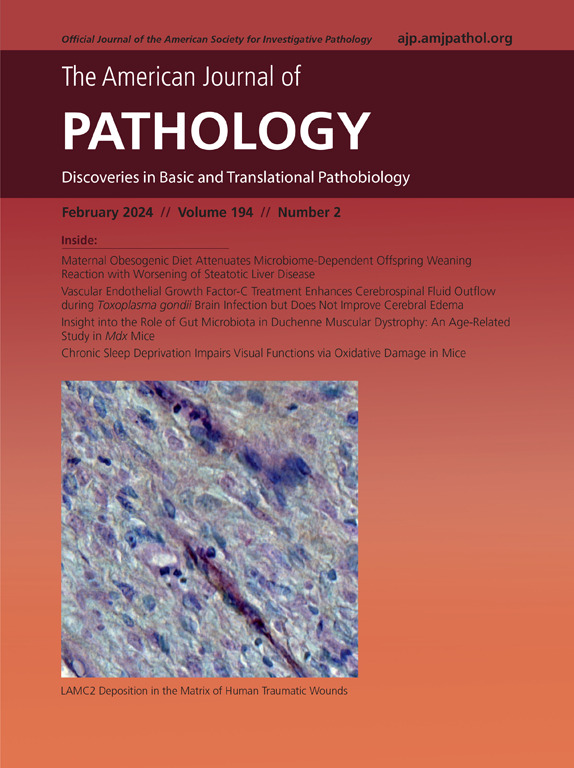鞘氨醇激酶 2 通过 p53 调节 miR-205 和 miR-296 来控制口腔鳞状细胞癌的侵袭性表型。
IF 3.6
2区 医学
Q1 PATHOLOGY
引用次数: 0
摘要
头颈部鳞状细胞癌(HNSCC)与微RNA、p53和鞘脂代谢的改变有关。然而,鞘磷脂代谢中的一个关键酶--鞘氨醇激酶2在HNSCC中的作用却鲜为人知。我们的目的是研究 SK2 和 p53 如何相互作用调控 miR-205 和 miR-296。通过分析SK2过表达(NOK-SK2)与NOK对照(NOK- Ø)的非肿瘤口腔角质细胞的small-RNA-seq数据,发现100多个miRNA的表达存在差异,其中一半受p53调控。在NOK-SK2细胞中,miR-205的表达下调,miR-296的表达上调;然而,敲除SK2和p53过表达的细胞则表现出相反的情况。miR-205模拟物和miR-296抑制剂降低了SK2失调的口腔角朊细胞和口腔癌细胞的侵袭性和癌症干样细胞。在HN12-SK2细胞中过表达miR-205可降低肿瘤形成能力,NOK-SK2细胞可抑制小鼠肿瘤生长。我们的研究结果表明,SK2和p53在调控miR-205和miR-296方面存在交叉作用,而miR-205和miR-296可能是HNSCC治疗的潜在靶点。本文章由计算机程序翻译,如有差异,请以英文原文为准。
Sphingosine Kinase 2 Controls the Aggressive Phenotype of Oral Squamous Cell Carcinoma by Regulating miR-205 and miR-296 through p53
Alterations in miRNAs, p53, and sphingolipid metabolism are associated with head and neck squamous cell carcinoma (HNSCC). However, the role of sphingosine kinase (SK)-2, an enzyme crucial for sphingolipid metabolism, is poorly understood in HNSCC. The aim of this study was to investigate how SK2 and p53 interact to regulate miRNAs miR-205 and miR-296. Analysis of small-RNA sequencing data from nontumor oral keratinocytes with SK2 overexpression (NOK-SK2) compared to controls (NOK-Ø) revealed differential expression of >100 miRNAs being half-regulated by p53. The expression of miR-205 was down-regulated, and miR-296 was up-regulated, in NOK-SK2 cells; however, cells with SK2 knockdown and p53 overexpression showed an opposite profile. Proteins involved in miRNA biogenesis were increased in NOK-SK2 cells, while levels were decreased in NOK-SK2 cells with p53 overexpression. Transfection with miR-205 mimic and miR-296 inhibitor decreased the aggressiveness and the number of cancer stem-like cells in oral keratinocytes and oral carcinoma cells with SK2 regulation. Overexpression of miR-205 in HN12-SK2 cells decreased tumor-formation capacity, and NOK-SK2 cells abrogated tumor growth in mice. The results indicate crosstalk between SK2 and p53 in regulating miRNAs 205 and 296, which could be potential therapeutic targets in the treatment of HNSCC.
求助全文
通过发布文献求助,成功后即可免费获取论文全文。
去求助
来源期刊
CiteScore
11.40
自引率
0.00%
发文量
178
审稿时长
30 days
期刊介绍:
The American Journal of Pathology, official journal of the American Society for Investigative Pathology, published by Elsevier, Inc., seeks high-quality original research reports, reviews, and commentaries related to the molecular and cellular basis of disease. The editors will consider basic, translational, and clinical investigations that directly address mechanisms of pathogenesis or provide a foundation for future mechanistic inquiries. Examples of such foundational investigations include data mining, identification of biomarkers, molecular pathology, and discovery research. Foundational studies that incorporate deep learning and artificial intelligence are also welcome. High priority is given to studies of human disease and relevant experimental models using molecular, cellular, and organismal approaches.

 求助内容:
求助内容: 应助结果提醒方式:
应助结果提醒方式:


